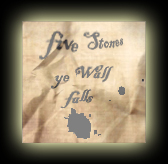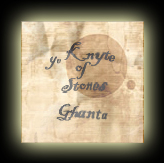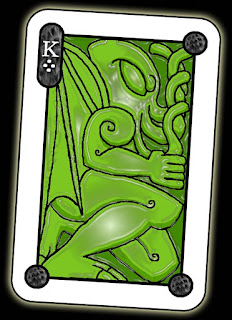As
part of the launch of the Innsmouth Tarot Project, the Miskatonic Folklore
Field Study Unit is proud to announce that all of the original source materials
will be put on display to the public at a special exhibition held at the Kester
Library in Salem, Massachusetts. The exhibition will contain all of the
chap-books and common-place books collected in the course of putting together
the tarot card set, along with the original cards discovered beneath the
Library’s floorboards and the set of cards and other artefacts on loan from the
Newburyport Historical Society. A rare viewing of the original Ponape Scriptures will also feature as
part of the event.
This
exhibition – with accompanying lectures – will take place in mid-August and the
Innsmouth Tarot cards will be available for sale in the gift shop. All proceeds
from the event will go towards the ongoing restoration work at the Kester
Library.
*****
The
final suit of the Lesser Arcana is the suit of Stones which represents the
physical underpinnings of existence, their manipulation and expression. It
equates to the Pentacles, or diamonds, suit of traditional decks and is linked
to the Ancient Greek element of earth.
*****
The Ace of Stones
The
quintessence of physical power, the Ace stands for worldly capability and
material wealth. When it arrives in a reading it is an omen of impending
prosperity.
This
card heralds the onset of bliss, ecstasy and physical contentment. It signifies
attainment and wealth, the presence of gold or treasures and great wealth. In
some instances, it foretells the discovery of important antiques, old coins, or
a significant rock. When upside-down, it foretells of wealth that brings no
pleasure, ill-gotten gains that are a burden, or corruption by money.
The Two of Stones
The
hurled rock – emblematic of the sudden blow or the unexpected statement – is
the catalyst from which rapid and turbulent change may spring. The thrown stone
might be a pebble, or it might be a planet-sized object hurtling from the
heavens – either way, when it strikes, nothing will be the same again.
The
divinatory meaning of this card is the arrival of troubles, difficult
situations arising, or a failure to launch. When inverted, it signifies
literary ability or competence in handling difficult matters. It also indicates
being forced to feign enjoyment or happiness.
The Three of Stones
The
perfectly-cut, flawless gem speaks of great skill and competence. It is an
harmonious combination of artistry, science and an accident of nature.
This
card speaks of great skill in trade or work; the mastery and skilful deployment
of the skills which define one’s daily occupation. It implies perfection as the
end results of one’s efforts. When upside-down, it betokens sloppiness,
poor-quality work and mediocre results. It also heralds money troubles.
The Four of Stones
A
treasure chest might seem like a good way to protect one’s assets, but with it
come attendant troubles such as secrecy, rumour and the possibility of
forgetfulness. The promise of security is false and simply leads to other woes.
The
meaning of this card is an obsession with money matters leading to inequities
in one’s life. Miserliness; hoarding; gambling problems: nobody likes a
skinflint. When inverted, the card reads as a warning about imminent issues
which curtail the gaining of funds: obstacles, delays and suspense.
The Five of Stones
The
high fortress wall protects and maintains. Sometimes we grow blind to its
nurturing presence, only to realise its necessary purpose in our lives after it
falls down.
Ruin
is the meaning of this card: loss; an error in practise or judgement; the
realisation of the importance of something only now that it has gone. It
signifies the loss of material wealth or physical protection. When upside-down,
it tells of the overcoming of ruin, or the reversal of a bad trend.
The Six of Stones
The
gift of a tribute – whether given or received – is a mark of esteem and bestows
honour upon both sides of the equation. The tithe is a mark of humility and a
realisation of one’s place within a community: in essence, the offering says
that one understands one’s place within a greater circumstance.
It’s
no surprise, then, that this card tells of charity, or generosity, in one’s
future dealings. Inverted, it speaks of the opposite – avarice, greed and
miserliness; the inability to give of one’s self in an undertaking.
The Seven of Stones
The
holey, or self-bored, stone is a symbol of luck throughout the world, common to
many races and cultures, and so it is not unusual to find it as a feature of
Deep One folklore. Such stones are rare and are dependent upon fairly peculiar
combinations of eroding forces and mineral types – their discovery is always
thought to be a good omen.
When
found in a reading, the Seven of Stones indicates ingenuity in an undertaking.
It talks of growth and success in business and gratifying outcomes stemming
from hard work. Upside-down, it betokens anxiety and impatience; rushed
decisions and bad calls.
The Eight of Stones
The
weathered rock has stood for a long time in the elements and, while some
edginess has been pared away, the stone has found its place within the
environment and will endure as a result.
This
card tells of apprenticeship – a long process of conditioning leading to a
fortunate outcome. In many ways it speaks of the power of the individual to
progress in their chosen field. When inverted, it reveals vanity, conceit and a
lack of ambition through disillusionment.
The Nine of Stones
The
carved stone is a hallmark of the artisan’s skill. With such skills, the artist
can prosper through his efforts and ensure his material security in the world.
The
card embodies the notion of working towards security and safety. It speaks of
foresight and forward-planning, prudence, and the ability to make the right
judgement when required. Upside-down, it foretells a loss of security, dangers
approaching, waste of resources and coming storms.
The Ten of Stones
The
seam of gold is a happy discovery and a hallmark of coming prosperity. However,
the gold does not simply shake itself from its bedrock: the seam must be
worked, and this promise of occupation and productivity is its own reward. It
is an assurance of success and a safe future.
When
it shows up in a card spread, the seam indicates all of the best aspects of
material wealth – safety and security; riches and comfort. When inverted, it signifies
risk – a poor use of judgement; a bad tip; and untenable odds.
Yibb-Tstll – The Jack of
Stones
Yibb-Tstll,
also known as “Chuma” amongst some nomadic Saharan tribes, is the last of the
three entities referred-to as the “Drowners”, after Bugg Shash and Nyogtha. As
stated previously, it’s not known whether these beings are Great Old Ones in
their own right or are perhaps some kind of symbiotic creatures – possibly
parasitic – which derive some kind of benefit from association with those entities.
Grimoire references, intercessory chants and ritual spells all link them
inextricably to the major figures of the Deep One mythology, regardless of
their purpose.
Yibb-Tstll
is a major figure appearing in a rare work entitled the Cthaat Aquadingen and its related text, the Codex Dagonensis. It is linked to several retaliatory incantations
designed to summon a toxic substance called “The Black” which, by inference, would
seem to be Yibb-Tstll’s blood, a material considered to have an independent existence
from its source. Some sources consider Yibb-Tstll to dwell only in dreams and
this notion may hold some currency, considering the dream connections to Great
Cthulhu.
When
appearing in a card reading, Yibb-Tstll implies a need for study, deep reflection
and concentration. This card stands for scholarship and a desire for learning
and the new ideas which such effort engenders. The reverse meaning of this card
is rebelliousness, the de-valuing of ideas. It stands for unrealistic thinking
and the failure to recognise obvious facts. It heralds illogical thinking.
Ghatanothoa – The Knight of
Stones
Ghatanathoa
– sometimes called “Ghanta” – is the eldest child of Cthulhu spawned upon its
first wife, Idh-Yaa. In the ancient – some would say mythical – kingdom of Mu,
Ghatanothoa held primacy as the god of the main religion and its temples and
priests were the wealthiest and most respected. Legends tells us that
Ghatanathoa was brought to Earth by beings from an unknown planet named Yuggoth
and installed beneath a mountain named Yaddith-Gho on Mu, from which locale it
became an object of veneration. Details of what Ghatanothoa might look like are
sketchy; in various texts it is only mentioned that it “is not good to look
upon” with the implication that such an act might be deadly.
Ghatanothoa
in a card reading indicates the presence of a steady and determined individual
with the skills and dedication to see a task through to its conclusion. It
stands for a methodical presence, imbued with perseverance, having the ability
to see a task through to its conclusion. When upside-down, it speaks of limited
vision; an adherence to dogma; stagnation and inertia; carelessness in
completing tasks.
Idh-Yaa – The Queen of
Stones
Idh-Yaa
is conceived of as an enormous pale nematode-like creature hailing from a
planet orbiting the distant (currently unidentified), double-star, Xoth. With
Cthulhu, it produced Ghatanothoa, Zoth-Ommog, Ythogtha and Cthylla, but it is
unknown whether it came to Earth with Cthulhu and its offspring, descending
from the heavens as “cosmic pus”. References to Idh-Yaa are confined mainly to
the Ponape Scriptures and some have
interpreted its lack of prominence within Deep One worship as an indication
that it is considered less of an entity and more of a generative principle.
When
Idh-Yaa shows up in a card reading, it symbolises abundance and wealth, coupled
with a sense of majesty and magnificence. It may indicate a highly accomplished
moneyed person of great grace and dignity. When inverted, Idh-Yaa heralds a
vicious and untrusting person; someone capable of great suspicion and
vengeance. It may also betoken false prosperity suspense and a neglect of one’s
responsibilities.
Cthulhu – The King of
Stones
This
avatar of the Great Old One Cthulhu is the one which is most often thought of.
We have chosen to depict it as carved from green Chinese jade, as fitting for
this suit of cards. The Kester Library set of cards is everything one would
expect from this being.
The
meaning of this card is loyalty and dependability. It signifies a person of
great experience, a successful leader with business acumen, mathematical
ability and high intelligence. When turned upside-down, it speaks of vice and
corruption; the thought that the end justifies the means. It implies
faithlessness.
*****
The Innsmouth Tarot is an inter-disciplinary production of
the Miskatonic University, drawing on the talents of the faculty’s best minds
in the fields of Anthropology, Folklore, English Literature and History. The
team which researched, studied and produced the cards was headed by Dr. Rhonda
Wilmarth, PhD.
The Innsmouth Tarot is being issued by The Miskatonic University Press in a single print run, comprising a
deluxe version of only 100 copies presented in a gilt-decorated, white calf
clamshell box, with a 96-page hardcover book of commentaries, interpretations,
and a variety of divinatory spreads with which to practice. All 78 cards are
printed on high quality, high-slip stock, edged in gilt. This deluxe version
costs $150.
The
standard version of The Innsmouth Tarot
comprises 78 high-slip, gilt edged cards in a decorated cardboard mailer,
including a pamphlet of card meanings and divinatory card spreads. The standard
version of The Innsmouth Tarot costs
$49.95.
The
cards each display a unique ‘manta ray’ design on the verso.
Purchases
can be made by contacting The Miskatonic
University Press online and quoting your credit card number. Shipping
charges are extra.
The
Innsmouth Tarot – ISBN 0-85030-1718
The
Innsmouth Tarot, Deluxe Version – ISBN 0-59527-3335























No comments:
Post a Comment